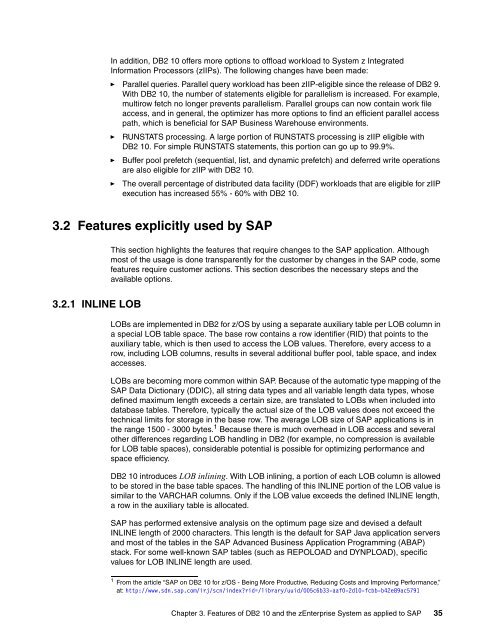Download PDF - IBM Redbooks
Download PDF - IBM Redbooks
Download PDF - IBM Redbooks
Create successful ePaper yourself
Turn your PDF publications into a flip-book with our unique Google optimized e-Paper software.
In addition, DB2 10 offers more options to offload workload to System z Integrated<br />
Information Processors (zIIPs). The following changes have been made:<br />
► Parallel queries. Parallel query workload has been zIIP-eligible since the release of DB2 9.<br />
With DB2 10, the number of statements eligible for parallelism is increased. For example,<br />
multirow fetch no longer prevents parallelism. Parallel groups can now contain work file<br />
access, and in general, the optimizer has more options to find an efficient parallel access<br />
path, which is beneficial for SAP Business Warehouse environments.<br />
► RUNSTATS processing. A large portion of RUNSTATS processing is zIIP eligible with<br />
DB2 10. For simple RUNSTATS statements, this portion can go up to 99.9%.<br />
► Buffer pool prefetch (sequential, list, and dynamic prefetch) and deferred write operations<br />
are also eligible for zIIP with DB2 10.<br />
► The overall percentage of distributed data facility (DDF) workloads that are eligible for zIIP<br />
execution has increased 55% - 60% with DB2 10.<br />
3.2 Features explicitly used by SAP<br />
3.2.1 INLINE LOB<br />
This section highlights the features that require changes to the SAP application. Although<br />
most of the usage is done transparently for the customer by changes in the SAP code, some<br />
features require customer actions. This section describes the necessary steps and the<br />
available options.<br />
LOBs are implemented in DB2 for z/OS by using a separate auxiliary table per LOB column in<br />
a special LOB table space. The base row contains a row identifier (RID) that points to the<br />
auxiliary table, which is then used to access the LOB values. Therefore, every access to a<br />
row, including LOB columns, results in several additional buffer pool, table space, and index<br />
accesses.<br />
LOBs are becoming more common within SAP. Because of the automatic type mapping of the<br />
SAP Data Dictionary (DDIC), all string data types and all variable length data types, whose<br />
defined maximum length exceeds a certain size, are translated to LOBs when included into<br />
database tables. Therefore, typically the actual size of the LOB values does not exceed the<br />
technical limits for storage in the base row. The average LOB size of SAP applications is in<br />
the range 1500 - 3000 bytes. 1 Because there is much overhead in LOB access and several<br />
other differences regarding LOB handling in DB2 (for example, no compression is available<br />
for LOB table spaces), considerable potential is possible for optimizing performance and<br />
space efficiency.<br />
DB2 10 introduces LOB inlining. With LOB inlining, a portion of each LOB column is allowed<br />
to be stored in the base table spaces. The handling of this INLINE portion of the LOB value is<br />
similar to the VARCHAR columns. Only if the LOB value exceeds the defined INLINE length,<br />
a row in the auxiliary table is allocated.<br />
SAP has performed extensive analysis on the optimum page size and devised a default<br />
INLINE length of 2000 characters. This length is the default for SAP Java application servers<br />
and most of the tables in the SAP Advanced Business Application Programming (ABAP)<br />
stack. For some well-known SAP tables (such as REPOLOAD and DYNPLOAD), specific<br />
values for LOB INLINE length are used.<br />
1 From the article “SAP on DB2 10 for z/OS - Being More Productive, Reducing Costs and Improving Performance,”<br />
at: http://www.sdn.sap.com/irj/scn/index?rid=/library/uuid/005c6b33-aaf0-2d10-fcbb-b42e89ac5791<br />
Chapter 3. Features of DB2 10 and the zEnterprise System as applied to SAP 35

















